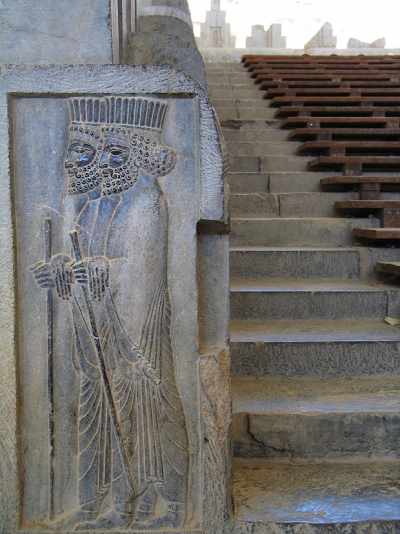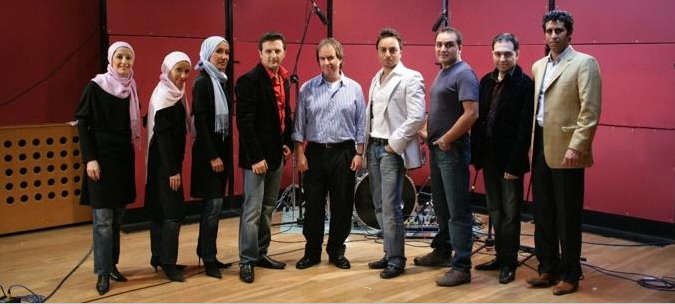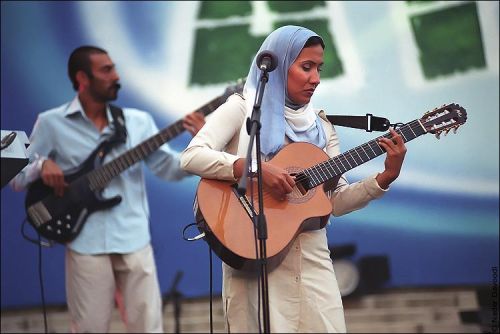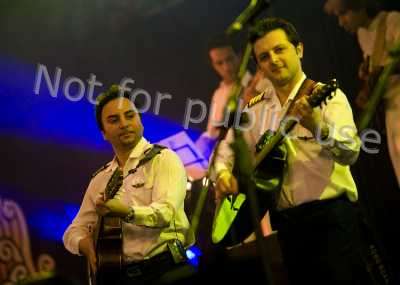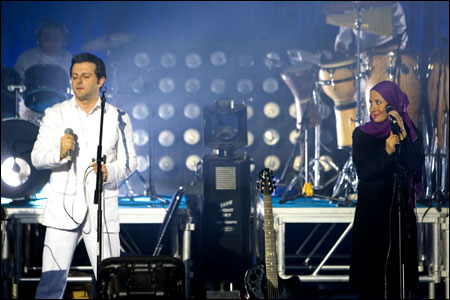After more than 600 days of planning, filming and post production work, the VISION BEIJING film project held its global premiere on February 24, 2008, in Beijing. The works of five world-famed directors who participated the project were shown to the public, serving as an audio-video record of the rich connotations of Beijing People's Olympics. Meanwhile, this event will provide the world with some insights into Beijing's history and culture in an engrossing and entertaining way.
The VISION BEIJING project is sponsored by the Information Office of the Beijing Municipal Government, the Beijing Foreign Cultural Exchanges Association and the Beijing Tourism Administration. It was organized by the Beijing Foreign Exchanges Center and Beijing This Month Publications.
Five of the World's Best Film Directors, Giuseppe Tornatore (Italy), Majid Majidi (IRAN), Patrice Leconte (France), Daryl Goodrich (England) and Andrew Lau Wai-Keung (Hong Kong), were invited to make a short film each about Beijing and its people’s preparations for the 2008 Olympic Games.
Following their own styles, these five well-known directors told five stories of Beijing in their own ways. These passionate and inspirational films portray the beauty and charm of this ancient yet rapidly modernizing international metropolis and the host of the 2008 Olympics.
It was also the first time for Majidi to China. After showed around and after visiting Beijing’s World Cultural Heritage sites, the Beijing Urban Planning Exhibition Hall, the Beijing Shichahai Sports School and the Beijing Beihai Kindergarten;

He said: “He was particularly impressed by the vitality of elder people. This was my first chance to experience Beijing, but I feel very warm here, as our cultures are connected. China is a mysterious and wonderful place, and the Chinese people make this place mysterious and wonderful.”
"I am most impressed by the middle-aged and retired people, who have great passion for life," he added later.
Despite his impression for the elderly, Majidi, Oscar-nominated for Academy Award for Best Foreign Language Film with Children of Heaven in 1998, chose his favorite subject, children.
In Colors Fly, Majidi focused on children looking forward to the Games.
Children are typically Majidi’s favorite film actors and subjects. He is always inclined to portray the real lives of common people.
Majidi is known for his sensitive portrayal of children in films such as Children of Heaven and Color of Paradise.
In his short film, Majidi captures a group of ordinary Beijing students in yellow, blue, green, purple and red clothes on a morning in Beijing. The students are shown riding their bicycles as they bear their colorful wish-filled balloons through crowds, parks, streets, office buildings and public squares. On various plazas around the city, the students let fly their balloons which attract the attention of people in the area. The balloons soar before coalescing into beautiful Olympic rings. The final scene caused thunders of applause at the premiere.
In Tornatore's first trip to China, the Italian, Academy Award winner for Nuovo Cinema Paradiso in 1999, made Reunion, telling a story about how a group of students and their teacher got back together after 30 years.
Leconte was a stranger to Beijing too but he soon caught up with his knowledge for the Chinese capital, shooting Beijing -- A Film Impressionistic. Arguably France's best director, Leconte depicted Beijing through various structures including Summer Palace, Olympic venues and modern constructions.
Retired as an athlete, Goodrich found his career in a combination of sport and film-making.
After his success in his promotional film for London's bid for the 2012 Olympics, he joined Vision Beijing.
His five-minute film, entitled Belief, focused on the hard work and thrill of athletic competition.
Hong Kong director Lau, the only Chinese director invited to the project, showed his love for the Chinese food in Color, Fragrance, and Taste Beijing.
Lau, having a large group of fans in China thanks to his hit works including Storm Riders, Infernal Affairs and Initial D, showed different types of famous Chinese food and depicted relations between food and Chinese culture.
"I love food so I am the right person to make the film," said Lau half-jokingly. "The only problem is there are too many types of food for me to choose for my film. I just have to show the best of the best."
(Xinhua News Agency February 25, 2008)
The Organizing Committee also enjoyed the support of society. More than 10 cultural celebrities served as advisors to the project, such as Xu Zhihong, Liu Huan and Ma Wei; many famous actors participated, such as Zhang Yang, Tian Zhuangzhuang and Jiang Wenli. More than 100 sites were used as shooting scenes. Nearly 300 film-makers and more than 1,500 working staff, nearly 30 famous actors and sports stars and more than 2,800 extras were involved in this project.
After the premiere ceremony, these five films will be shown via CCTV-2, Beijing TV, the national TV stations of IRAN, Italy, France, and on flights of Air France, Air China, in cinemas in Beijing, via Beijing’s city TVs, mobile TVs, subway TVs, city big-screen TVs and during other cultural exchange occasions.
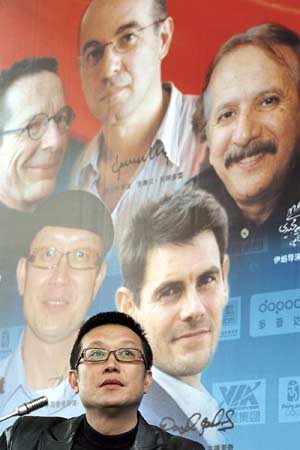
Hong Kong director Andrew Lau Wai Keung listens to a question during the Vision Beijing news conference in Beijing yesterday.
The project has showcased five short films by five world famous film directors, namely Lau, Giuseppe Tornatore of Italy, Majid Majidi of IRAN, Patrice Leconte of France, and Daryl Goodrich of England. The short films are about Beijing and the people's preparations for the 2008 Olympic Games.
In Leconte's "Beijing-A Film Impressionistic," there is no storyline but like an impressionist painting. There are many images like kites flying in the sky, the Great Wall, the Temple of Heaven, the National Stadium and people performing acrobatics in this impressionistic "painting". Watch the film 
Following his signature theme of children, Majidi has them in his film to send Beijing's best wishes for the Olympics and hopes for a harmonious world. Named "Colors Fly", the short movie features a group of children who fly balloons in the five colors of the Olympic rings. As the children ride the bicycles on the street, they release the balloons with wishes written on them.
Watch the film
[Can also watch Colors Fly Here]
In comparison with Leconte's images, Andrew Lau focuses his camera on enticing food in Beijing. In the Hong Kong's five-minute movie, he shows the delicious buffet of food, including Peking duck in fancy restaurants and snack stands along the street. The shots of the food are enough to make any viewer hungry. Watch the film

Finally, compared with the other four films, Italian director Giuseppe Tornatore's work is a complete story. His film begins with a busy Beijing morning, when a bus driver surnamed Li recognizes an elderly woman doing tai chi in the park is his former teacher. What follows are scenes of people with various occupations, like construction workers, Peking opera singers and tricycle riders. The story follows with Li writing to her former classmates to organize a reunion with their teacher. Watch the film
Biography of Majid Majidi
Majid Majidi (Persian: مجید مجیدی , born 17 April 1959 in Tehran) is an internationally and critically acclaimed Iranian film director, film producer, and screenwriter.
Born in an Iranian middle class family, he grew up in Tehran and at the age of 14 he started acting in amateur theater groups. He then studied at the Institute of Dramatic Arts in Tehran.
After the Iranian Revolution in 1979, his interest in cinema brought him to act in various films, most notably Mohsen Makhmalbaf's Boycott in 1985.
As of 2004, Majidi was the only Iranian director who has been nominated for an Academy Award for Best Foreign Language Film with the film Children of Heaven in 1998. He lost the award to the Italian film Life Is Beautiful by Roberto Benigni.
2) Hoodaj (1984) - short
3) Examination Day (Rooz-e Emtehan) (1988) - short
4) A Day with POWs (Yek Rooz Ba Asiran) (1989) - documentary short
5) Baduk (1992) - debut feature
6) The Last Village (Akhareen Abadi) (1993) - short
7) Father (Pedar) (1996) - feature
8) God Will Come (Khoda Miayad) (1996) - short
9) Children of Heaven (Bacheha-ye Aseman) (1997) - feature
10) The Color of Paradise (Rang-e Khoda) (1999) - feature
11) Baran (Rain) (2001) - feature
12) Barefoot to Herat (Pa berahneh ta Herat) (2002) - documentary
13) Olympics in the Camp (Olympik Tu Urdugah) (2003) - documentary short
14) The Willow Tree (Beed-e Majnoon; alternate English title One Life More) (2005) - feature
15) Peace, Love, and Friendship (2007) - documentary short
16) The Song of Sparrows (2008) - feature
17) Kashmir Afloat - in production.
Majid Majidi has received numerous awards up to now. Here are a few:
1) Ecumenical Special Award, 25th Montreal Film Festival, 2001.
2) Grand Prix Des Ameriques, 25th Montreal Film Festival, 2001.
3) Oscar-Nominated for Academy Awards for Best Foreign Film, 1998.
4) Grand Prix of Americas Best Film, 21st Montreal Festival for World Films, 1999.
Sources:
Wikipedia, China Daily, BoomTownBeijing, china.org.cn, BTMBeijing







